| Pages:
1
..
3
4
5
6 |
AndersHoveland
Hazard to Other Members, due to repeated speculation and posting of untested highly dangerous procedures!
    
Posts: 1986
Registered: 2-3-2011
Member Is Offline
Mood: No Mood
|
|
Those types of halogen substitution reactions can be difficult. Typically both the reactants must be able to dissolve in the solvent. Either that, or
both the products must.
|
|
|
Alastair
Hazard to Self
 
Posts: 59
Registered: 13-7-2011
Member Is Offline
Mood: Barely any solvent in my emulsion
|
|
In that case, is silver nitrite necsessary or simpler sodium would do? (In one book the synthesis needed AgNO2)
|
|
|
simba
Hazard to Others
  
Posts: 175
Registered: 20-5-2011
Member Is Offline
Mood: No Mood
|
|
Quote: Originally posted by Alastair  |
In that case, is silver nitrite necsessary or simpler sodium would do? (In one book the synthesis needed AgNO2) |
sodium nitrite will work but silver nitrite gives higher yields.
|
|
|
Alastair
Hazard to Self
 
Posts: 59
Registered: 13-7-2011
Member Is Offline
Mood: Barely any solvent in my emulsion
|
|
I've just come up with an amazing idea.
What about excess EtOH + HCl and then just add hexamine and reflux? (ref. Delepine reaction)
Wait, that gives ethylamine, sorry.
[Edited on 29-9-2011 by Alastair]
|
|
|
Jimmymajesty
Hazard to Others
  
Posts: 153
Registered: 9-7-2009
Member Is Offline
Mood: No Mood
|
|
Hi folks,
I have been thinking how one could minimize the risk of explosion based on the run I did in a couple of years before, so what do you think about this
setup?
Advantages:
The HNO3 flask will be filled up with ceramic rings so the explosion space is limited to ~20cm3
The thermometer is inside the gas stream (Pt100)
Of course it is a 2D version of the setup, you have to rotate back the condenser to have the actual 3D version that will be put under the test. But I
am sure you know how it will be used.
Any comments would be welcomed.
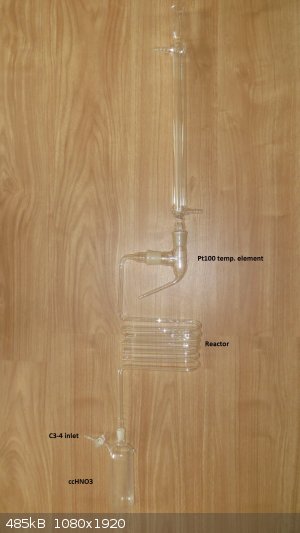
|
|
|
Jimmymajesty
Hazard to Others
  
Posts: 153
Registered: 9-7-2009
Member Is Offline
Mood: No Mood
|
|
so... I jerry-rigged a lil setup today.
I used a nebulizer to make HNO3 spray the entrainer was P-B gas mixture from a cigarette lighter.
Problems were as expected:
There were large droplets in the spray which came to gether in the tube causing mini explosions.
I could not keep the PB flow constant so in 95% of the 2 min operation there was a flame inside the quartz tube.
I tried to collect the products in water by placing a beaker to the outlet. There was nothing but a strong formaldehyde smell with a pinch of almond.
All in all I quite optimistic about this simple design ---forget the complex glassware posted above--- I think in a couple of weeks I can come back
with some real yields!
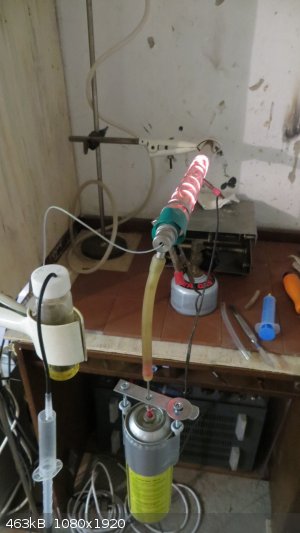
|
|
|
Magpie
lab constructor
    
Posts: 5939
Registered: 1-11-2003
Location: USA
Member Is Offline
Mood: Chemistry: the subtle science.
|
|
Jimmy I don't know anything about what you are doing here but I'm impressed with your technochemistry creations. IMO you are doing the most exciting
research on this forum.
I'm going to have to look into the workings and use of a nebulizer.
For flow control have you considered a needle valve and gas rotameter?
Edit: A pressure regulator would also be a help if the up stream pressure varies. I know this all costs money - but with your creativity you might
bring the cost down. 
[Edited on 1-4-2015 by Magpie]
[Edited on 1-4-2015 by Magpie]
The single most important condition for a successful synthesis is good mixing - Nicodem
|
|
|
Jimmymajesty
Hazard to Others
  
Posts: 153
Registered: 9-7-2009
Member Is Offline
Mood: No Mood
|
|
Magpie, like NurdRage says, we are here to explore the science
The 20kg PB tank is on its way, then the flow control problem will be solved.
If I were to measure real flow I would use the heated filament method, but I do not think it is necessary at garage level chemistry.
There are two possibilities:
Spraying form above - glasswork needed
HNO3 vapors from below - explosion risk... but you do not have to worry about large HNO3 droplets. So I favor this.
|
|
|
Praxichys
International Hazard
    
Posts: 1063
Registered: 31-7-2013
Location: Detroit, Michigan, USA
Member Is Offline
Mood: Coprecipitated
|
|
This whole thread is very interesting.
What about making a steel bomb, add nitric acid, pressurize with liquid propane, and then heat it (remotely!) to the required temperature, let it
cool, relieve pressure, and fractionate the contents?
|
|
|
Jimmymajesty
Hazard to Others
  
Posts: 153
Registered: 9-7-2009
Member Is Offline
Mood: No Mood
|
|
Praxichys you do not need to relieve the pressure after the reaction, you surely have to collect the shrapnels though.
Note that in the experimental setup above only nitric acid and CH was present still there was a jet like flame all along the tube, and it is not just
some dancing flame it had a sharp noise, if you premix the reactants and heat them I am absolutely sure that a violent explosion will occurr.
If you want to explore alternative routes.. I read somewhere that alkyl nitrites can rearrange under pressure and heating to nitro compounds, so you
rather try heating some isopropyl nitrite to get the nitro compound I think there will be oxidation reactions too so, maybe 40-50% yield but depending
on the applied temps some nitromethane and ethane will form too.
|
|
|
Magpie
lab constructor
    
Posts: 5939
Registered: 1-11-2003
Location: USA
Member Is Offline
Mood: Chemistry: the subtle science.
|
|
I would be wary of using nitrites for this because of the possibility of forming carcinogenic nitroso compounds.
The single most important condition for a successful synthesis is good mixing - Nicodem
|
|
|
Jimmymajesty
Hazard to Others
  
Posts: 153
Registered: 9-7-2009
Member Is Offline
Mood: No Mood
|
|
Hi Folks,
I did another microscale experiment.
The heating on the vial and reaction tube were controlled. The cc nitric was brought to boil the reactor tube was kept at dull red, the CH gas stream
pressure was at 30mbar
Findings:
PB reacts with nitric acid, the top acid layer in the vial turned dark brown on contact with the propane-butane and this layer bubbled intensely
without heating, sometimes in the gas mixture before the reactor the acid concentration was too high due to this overboiling phenomena, in this case
there was alyways backflame with a peculiar sound... it never ceases to scare the hell out of me.
NOx reacts with mercaptans to form a blue compound as can be seen in the picture. when these blue droplets flowed back to nitric there was an
immediate overboil and as a result backflame so...
I will countinue the experiments with 68% nitric and in the final setup will try to avoid the contact between the reactants before the reaction tube.
I also tried to condense the products with cold water, there were small oily droplets that disappeared in a couple of mins upon shaking. There was a
strong HCHO and CH3CHO smell which indicates that the temps were too high.
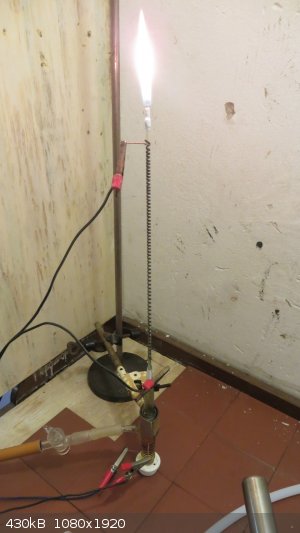 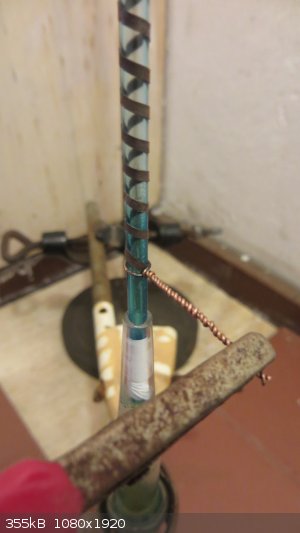
|
|
|
Loptr
International Hazard
    
Posts: 1347
Registered: 20-5-2014
Location: USA
Member Is Offline
Mood: Grateful
|
|
I screwed up my previous post. This replaces it.
What about hydrolysis and decarboxylation of the sodium salt of 3-nitropropionic acid starting from 3-chloropropionic acid?
EDIT: Nevermind. Addressed here: https://www.sciencemadness.org/whisper/viewthread.php?tid=11...
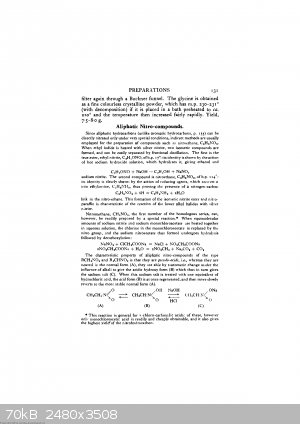
[Edited on 9-4-2015 by Loptr]
|
|
|
Jimmymajesty
Hazard to Others
  
Posts: 153
Registered: 9-7-2009
Member Is Offline
Mood: No Mood
|
|
Hi there
I finally scavenged all the parts to my new gas phase reactor, which happens to be good for preparation of nitro compounds as well.
Based on the previous experiences with middle and small scale equipments this should just do fine. (I think...)
Description:
Dark: Preheated air flush, below that is a small PTFE tube which goes through the boiling nitric and preheats the gas too somewhat.
Blue: Nitric A. vaporizer.
Red: Plug will shot out in case of an explosion, think of it as a PSV, in this picture this is grounded glass plug but it will be replaced with a PTFE
disk, and the glass and PTFE contact surface will be wetted with some silicone oil.
Yellow: C3-C4 + Nitric A. contact point.
Light green: C3-C4 + Nitric A. mixing section
Green: Reaction zone with wattage controller
Gray: Pt100
Red: Reaction product wash bottle and explosion trap
Rose: Leakage detector bottle
After the test runs with water the reactor will be filled up with raschig rings.
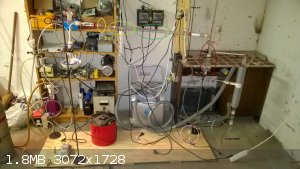
|
|
|
lullu
Hazard to Self
 
Posts: 51
Registered: 2-3-2012
Member Is Offline
Mood: No Mood
|
|
Jimmymajesty very nice upgrade! Looking forward to hear your reports on this.
|
|
|
Jimmymajesty
Hazard to Others
  
Posts: 153
Registered: 9-7-2009
Member Is Offline
Mood: No Mood
|
|
I cut my hand pretty badly, now that the stitches are removed I gained back enough dexterity to make a test run with water.
The only problem was that water accumulated at the ground glass joint and from time to time it flushed down on the evaporation zone and quickly boiled
away, this is exactly what needs to be avoided so a 60W heating element was included, also the whole evaporation and reaction zone was filled up with
inert ceramic balls. The role of the balls is to make the residence time lower and to decrease the reactor useful volume for fearing of an explosion.
I am quite pessimistic though that the glassware will withstand an explosion... at small scale experiments I managed to shatter the 1cm dia glass
reactor tube with 40ml useful volume, now we are talking about ~200ml, of course the reason why the small reactor exploded is eliminated in this setup
(I think), namely, the NOx+Gas mixture is not allowed to creep back into the nitric acid boiling flask by continuous air flush. The wall thickness of
the present reactor is also higher 2,5mm compared to 1mm, so I am going to beef up on protective gears and hope for the best.
![WP_20151108_22_11_46_Pro[1].jpg - 1.7MB](http://www.sciencemadness.org/talk/files.php?pid=426822&aid=45274)
|
|
|
Jimmymajesty
Hazard to Others
  
Posts: 153
Registered: 9-7-2009
Member Is Offline
Mood: No Mood
|
|
I did a testrun today with cc HNO3.
I flushed the setup with gas.
Heated up the reactor to 320°C
Brough the HNO3 to slight boiling
Everything seemed to work fine for 30min when I noticed that in the first wash flask the gas flow started to fluctuate (lot of bubbles then in the
next second hardly any) I thought ok it seems the HNO3 feed is almost over the explosion limit let leave it as it is, the next second the safety plug
shot out saving the equipment.
The reason of the mini explosion were the HNO3 condensate droplets running down onto the mixing point, at the first cm of the evaporation zone the
HNO3 droplets collected forming a larger drop that quickly evaporated pushing the gas+HNO3 mixture above the explosion limit. I have a nice solution
in mind to solve this.
During the 30min experiment small droplets formed at the bottom and on top of the water in the first wash flask indicating that a mixture of nitro
paraffins had been formed! 
![WP_20151115_22_05_21_Pro[1].jpg - 1.6MB](http://www.sciencemadness.org/talk/files.php?pid=427877&aid=45473)
|
|
|
Jimmymajesty
Hazard to Others
  
Posts: 153
Registered: 9-7-2009
Member Is Offline
Mood: No Mood
|
|
I totally redesigned the reactor today.
Upon disassembling after the test run the first wash flask totally smelled of hydrogen cyanide  The temp is measured outside the quartz tube reactor @320°C but quartz again a terrible heat conductor so the real
temp inside was much higher. Also a lot of formaldehyde was present. The temp is measured outside the quartz tube reactor @320°C but quartz again a terrible heat conductor so the real
temp inside was much higher. Also a lot of formaldehyde was present.
So at the new design:
The HNO3 will be boiling separately under slight pressure, when the vapors leave the small teflon tube right before the reaction zone it is slightly
superheated so condensation will not occur immediately(I hope...)
The whole reactor will be open. The beaker will be filled up with water, in case of an explosion the pressure blows down through the water, then the
water quickly flows back making the reactor operable again instantly. This was not the case with the teflon disk safety plug that had been shot across
the room and while I started to search for it the exhaust ground glass joint bursted into flames.
Now that the HNO3 is in the small teflon tube I do not need air flush at different points, so the reactor design became simpler.
The heating filament will be wounded up on a shorter section and the preheating section will be omitted. This is for shorten the residence time at
high temps even further.
![WP_20151118_22_43_11_Pro[1].jpg - 1.8MB](http://www.sciencemadness.org/talk/files.php?pid=428240&aid=45551)
|
|
|
zed
International Hazard
    
Posts: 2277
Registered: 6-9-2008
Location: Great State of Jefferson, City of Portland
Member Is Offline
Mood: Semi-repentant Sith Lord
|
|
Ummmm, well. Most of you seem to be intent on "cracking" propane. It isn't the best approach.
This probably be won't useful to the majority, but the gas of choice to use in these reactions is Ethane.
You want Nitro-ethane? Nitrate Ethane. Ethane isn't a rare gas anymore. So, it isn't very expensive anymore. With the advent of widespread
fracking, an excess amount of Ethane has been produced.
Since it burns hotter than Methane, there is a limit to how much Ethane, you can spike your Methane with. High Ethane Mixes, are reputed to burn out
natural gas "Burners". Not good!
That endless surplus of Ethane, needs selling somehow too..
Plans were, to sell tons (maybe hundreds, thousands, or millions, of tons)....to European refiners; for cracking into gasolines. Probably, it has
become a regular thing by now.
And, you could probably buys a few tons cheap, yourself........ if you had the right story-line, and a way to store the gas. But, what the hell
would you do with it all?
If you were planning to pull a "Heisenberg", a few tons of Ethane would make sense. But, we all know how that eventually turns out.
|
|
|
Jimmymajesty
Hazard to Others
  
Posts: 153
Registered: 9-7-2009
Member Is Offline
Mood: No Mood
|
|
I do not have ethane at hand, ofc the reaction products with ethane are simpler. My motive was the price for a litre of nitro methane equals to 13 kg
of propane butane gas mixture, so even with low yields it would worth a go and if your desired product is hydroxylamine the mixed reaction products
are not a problem.
So I tried out the setup described above, and another one as seen on the pic with liquid feed (H2O only) same problem with both ones. The liquid
reactant was spit onto the reaction zone. This in case with HNO3 caused mini explosions (in every 1 min). The explosions were handled well by the
reactor. I even allowed the reactants to burn in the reactor for some time but nothing formed but water.
To perform this reaction one would need a glass sprinkler nozzle that capable of fixing the molar ratio of the reactants to around 5. This would
require some high precision glasswork that is out of my reach. I can not think of any simple solution to bypass this, any ideas?
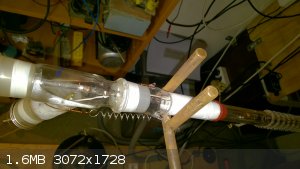
|
|
|
sclarenonz
Hazard to Self
 
Posts: 74
Registered: 13-12-2015
Location: BRASIL,oiapoque ,amapa
Member Is Offline
Mood: only the mission forget past
|
|
place the electrode positive just above the water, the nitrogen will react with water and form nitric acid, the other method would bring no2 until a
round valve with a large pressure and play heptane?
https://en.wikipedia.org/wiki/Bulk_loaded_liquid_propellants
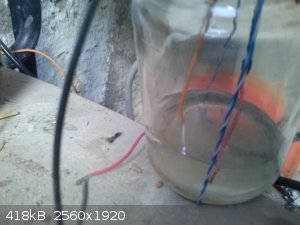 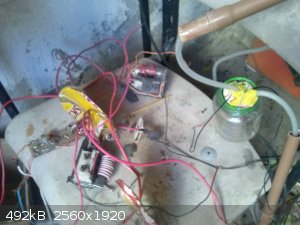
[Edited on 13-12-2015 by sclarenonz]
|
|
|
Jimmymajesty
Hazard to Others
  
Posts: 153
Registered: 9-7-2009
Member Is Offline
Mood: No Mood
|
|
Hi, I made ~1ml nitroparaffins today.
I used ~80% white fuming NA. Set the temp just below its boiling point. Turned on the gas feed, then cranked up the voltage on the glass tube heating
cartridge to have all the NOx disappear at the top of the reactor, you can see how it looked like during operation.
When I heated up first, a flame front went through the apparatus resulting in very mild explosion, this was handled well by the water bath, then I
increased the heating so that the brown fumes disappeared, there were still NOx at the low end of the heating cartridge this brown-colorless
transition pulsated (moved up and down about ~2cm in every 2 sec).
Some nitroparrafins dropped to the bottom of the beaker and some remained on top of the water, it burned with a grey flame and smelled very nice. The
droplets on the botton rose after 10-20min gave their half to the top layer then sank again.
It took me about 1hr to make this much, but I did not really try to optimise anything and I think large amount of the product just swept away by the
unreacted gas stream.
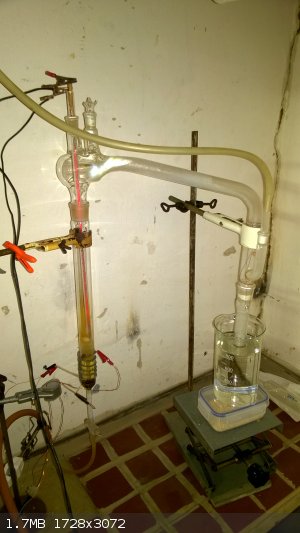 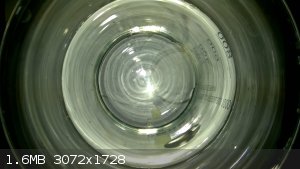
|
|
|
Oscilllator
National Hazard
   
Posts: 659
Registered: 8-10-2012
Location: The aqueous layer
Member Is Offline
Mood: No Mood
|
|
Well done Jimmymajesty. I know not a lot of members post replies to your experiments, but I just wanted to say your efforts have not gone unnoticed. I
have read all your posts and your perseverance over such a long period of time amazes me. Keep up the good work!
|
|
|
clearly_not_atara
International Hazard
    
Posts: 2691
Registered: 3-11-2013
Member Is Offline
Mood: Big
|
|
IIRC the only reagent capable of converting non-tert-alkyl-derived primary amines to nitro compounds is dimethyldioxirane:
http://www.sciencedirect.com/science/article/pii/09574166960...
In any case you need a highly electrophilic oxygen transfer agent which is not otherwise a good oxidant. HOF makes sense in that light, taking R=NOH
to R=N+(OH)2 and releasing F-
|
|
|
Jimmymajesty
Hazard to Others
  
Posts: 153
Registered: 9-7-2009
Member Is Offline
Mood: No Mood
|
|
Hey, thanks. I like the difficult ones because they send you on a learning trajectory, honestly I am quite amazed how many times I failed before I got
it right, basically I was like the foreign policy of USA, I tried out all bad ideas before I found one that yields some positive result (no offense
ofc)
So I collected the vaporized fraction too this time. Surprisingly this was only 1/3 of the total recovered amount. for 10ml 80w% HNO3 I got ~1ml
yellowish nitro propane/butane isomers. I am thinking about using recoverable hydrocarbons (bp>50°C), like hexane. I do not know about the yield
on C3-C4 but I think it is insanely low.
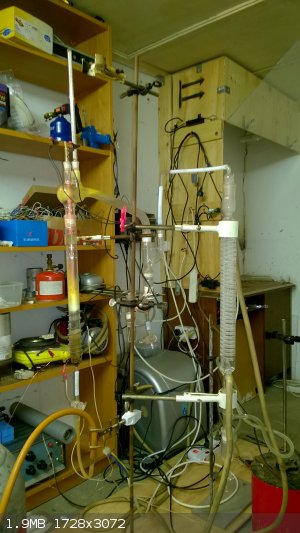 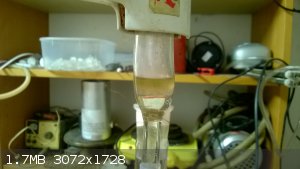
|
|
|
| Pages:
1
..
3
4
5
6 |